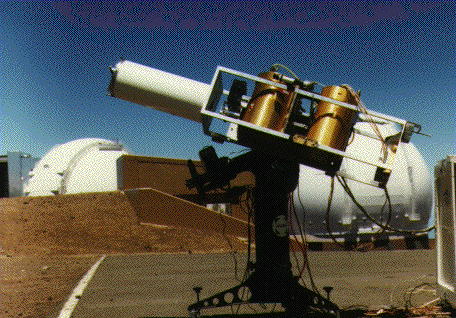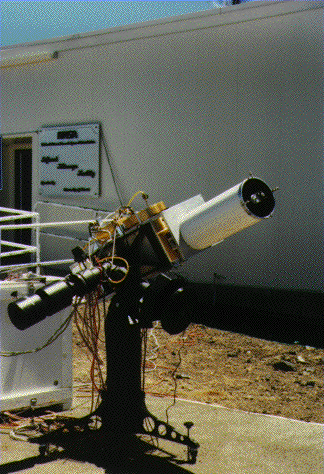BAM: Brackett Alpha Mapper
|
The BAM Project is dedicated to the study of the diffuse ionized interstellar hydrogen in the Galactic plane. This page gives basics of the project and describes recent developments. The instrument was developed at the Laboratory of Astronomy and Solar Physics (LASP), NASA/Goddard Space Flight Center by Alexander Kutyrev . This is a joint project of LASP and University of Wisconsin, Madison. Major participants are Charles Bennett and Harvey Moseley (LASP), and Ronald Reynolds and Fred Roesler (University of Wisconsin). The primary goal of this proposed project is to explore the global morphology and energy balance of the warm ionized component of the Galaxy and its relation to the other phases of the ISM. The Wisconsin H-alpha Mapper ( WHAM ) project will map the whole sky in H-alpha emission with 1 degree spatial resolution and 12 km/s velocity resolution. However, because of extinction in the disk of the Galaxy, most of the Galactic gas is inaccessible with \ha observations . In order to complete our picture of the overall morphology of this gas, we propose to carry out a ground-based survey of diffuse ionized Galactic hydrogen in the inner parts of the Galaxy, using powerful Fabry-Perot techniques in the infrared that are very similar to those successfully employed in the visible to observe the Brackett-alpha and Brackett-gamma lines. We have carried out a successful field test of this instrument,
where the Brackett-gamma emission line from
the diffuse warm ionized medium was detected for the first time.
The preliminary results of the survey have been presented at 4th
Grand Tetons meeting. We built a high performance near-IR Fabry-Perot spectrometer. The instrument, with high sensitivity, high spectral resolution (10000 and higher), and low spatial resolution (about 1 degree) is specifically designed for observations of the extended faint emission objects. It has the sensitivity to map the emission of the diffuse warm ionized hydrogen recombination lines Brackett-gamma (2.1655 micron wavelength) and Brackett-alpha (4.052 micron wavelength). The high throughput near-IR Fabry-Perot spectrometer has been designed and built at the Infrared Branch of the Laboratory for Astronomy and Space Physics by Alexander Kutyrev. |

We just completed (August 1996) first run of the instrument with large high performance infrared array detector. The picture shows the spectrometer set up at the Mauna Kea observatory, Hawaii. Large domes in the background are Keck telescopes. 
We had the instrument set up by the Infrared Telescope Facility. The spectrometer operates in two different modes: 1) without telescope, producing images of the sky on the detector, and 2) with the small 8" telescope attached, imaging entrance aperture on the detector (shown here). This image shows sequence of the interferograms of the laboratory hydorgen lamp obtained with the spectrometer. The diameter of the ring shanges as the spectrometer is tuned to different wavelength. This is the interferogram of the Galactic center region at Brackett alpha (4.05 microns), obtained on August 04, 1996. |


